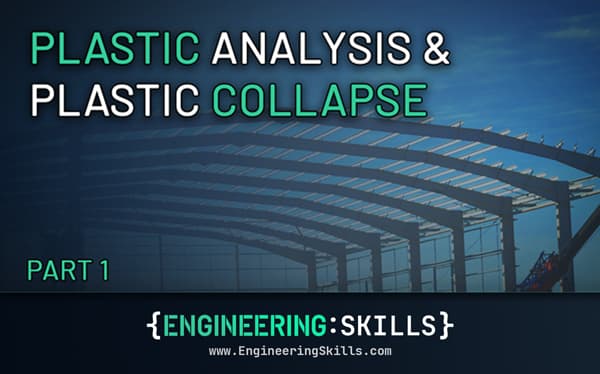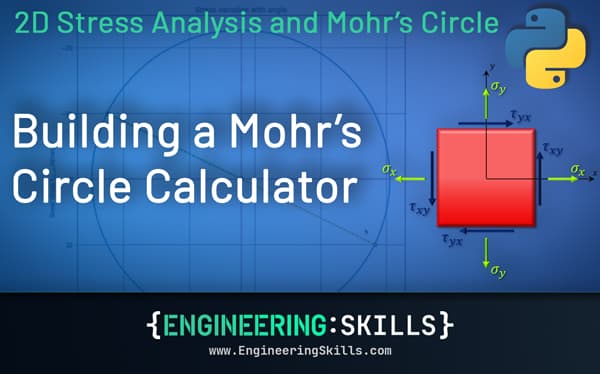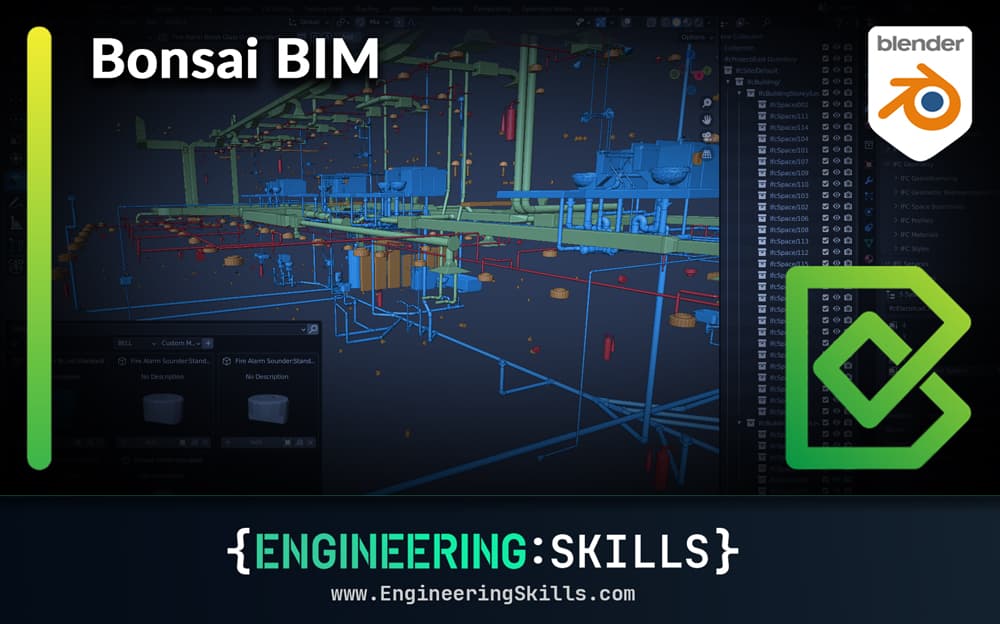A Complete Guide to Learning Structural Analysis
![[object Object]](/_next/image?url=%2Fimages%2Fauthors%2Fsean_carroll.png&w=256&q=75)
In this post, I want to provide a complete structural analysis guide – a roadmap for learning structural analysis from the beginning; what to study, in what order and why. This isn’t the only way, it might not even be the best way, but it’s logical and makes sense, to me at least. If you’re just starting to learn structural analysis, or, if you’re in the trenches, two or three years in and struggling – this post might help you chart a way forward.
1.0 The aim of this structural analysis guide
Learning how to use mathematics and mechanics to analyse structural behaviour takes a long time and a lot of effort. It is among the most challenging topics undergraduate students struggle with. Yet, for an engineer, particularly one involved in the analysis and design of structures, a firm grounding in fundamental structural behaviour is essential.
The road usually starts in the first year of an undergraduate engineering degree. This road winds through a range of topics, usually for the next three or four years. For many, the links between topics and the motivation for studying various theories and techniques gets lost along the way. Too often, people reach the third or fourth year of study and find themselves wondering how all of the half-understood, half-remembered methods of analysis link together – and why did they learn them in the first place when a computer programme can give an answer in a fraction of the time?
Even then, your knowledge base is highly theoretical, there is a whole separate effort required to understand how these theories and techniques translate into real-world structural behaviour. Something that usually becomes painfully apparent once you reach the design office as a freshly minted graduate engineer.
In this post, I want to focus on the acquisition of structural analysis knowledge in those first 3 or 4 years of undergraduate-level study. We’ll frame the discussion in the context of an undergraduate programme since that’s a progression most will be familiar with. I’ll lay out one possible roadmap to learning structural analysis. This is not the only way to do it, but if I was designing a path for someone, after many years teaching structural analysis, this would be my suggestion. As well as providing a guide for those at the start of the journey, this may also be helpful for those that are part-way along the path but who have lost sight of the bigger context that their knowledge fits into.
Naturally, I’ll point to a lot of the courses and resources here on EngineeringSkills, some free, like tutorial articles and Python projects and some paid like my premium courses. But there are many sources you can learn from – books, Youtube, articles online. All of the information is out there, for free in most cases these days. If you choose to buy a course from me, what you’re really buying is not the information itself but time; the time you save not having to curate and craft the information into a coherent learning pathway that I lead you along in the course. So let me say it again, all of the information is out there, you just need to decide how efficiently you want to consume it.
One more disclaimer, all this talk of roadmaps and journeys makes it sound like there is some final destination or finish line that, once reached, signifies the completion of your understanding, not so I’m afraid. I’m at this for over 20 years now, admittedly not long by comparison to some, but long enough and I’m still learning new things all the time. I don’t believe anyone could ever really fully master all aspects of structural analysis, any more than one could master all of mathematics. There is always more to learn and different topics to explore.
You can certainly become highly skilled in one or two areas but the field is vast and there is always someone who has explored further. A reasonable and achievable goal is to attain a high level of proficiency in the tools and techniques that you use on a regular basis. With this level of proficiency, it should be possible to teach yourself anything else in a related or tangential field when the need arises. This has always been my strategy – nail down the basics and use these to build your understanding of trickier topics and techniques – then start building on these…and so it continues.
2.0 Models of structural behaviour
Structural analysis is just the term we use to describe building and analysing mathematical models of structural behaviour. We use mechanics, which is just an abstraction of mathematics, to build models that we think represent our structures. Because these models are fundamentally just mathematical models we can feed them inputs and observe the outputs. In simple terms, the inputs are loads on the structure and the model outputs are our estimate of the structure’s response.
We can construct models of varying complexity, from simple stick models to huge finite element models with thousands of elements, Fig 1; the principle is always the same, the model is an approximation of the real-world structure. We can poke and prod the model and it will give us an idea of how the real structure would respond to the same poking and prodding.
The ability to model a structure and then analyse that model is a central requirement (among many others) of being a structural engineer. Beyond the mechanics and mathematics, the really tricky thing is understanding how and why your model behaviour might differ from the real thing, but that’s a discussion for another day.

Fig 1. Simply supported beam visualised with a line diagram and modelled from simple statics (left) and more complex finite element model consisting of hundreds of individual elements (right). Both approximate the same structural behaviour.
3.0 Buckets of knowledge
In engineering, we’re fond of categorising things into buckets. Structural analysis is no different, we have plenty of ways of breaking up this vast body of knowledge. Some categories are more arbitrary than others but generally speaking they’re helpful in breaking the theory up into more manageable chunks. For the sake of clarity going forward, let’s summarise a few of them here and say a few words on where they fit along the roadmap.
3.1 Planar 2D versus 3D structures
Obviously, we live in a three-dimensional world, but this doesn’t mean we need to always model or consider all three dimensions in our analyses. Very often the behaviour of a structure along one dimension is relatively simple or constant, i.e. not much is happening along this dimension so, quite often we simplify the structure into a 2D or planar model. Think of a tunnel or a retaining wall, for example; most of the interesting behaviour, the stresses and strains that develop in response to the loading on the structure can be analysed by modelling the cross-section. The longitudinal dimension can be ignored if our objective is to understand what’s going on at a ‘typical’ cross-section. We use this simplification regularly when we approximate a typical frame within a building by with a 2D planar model, Fig 2.
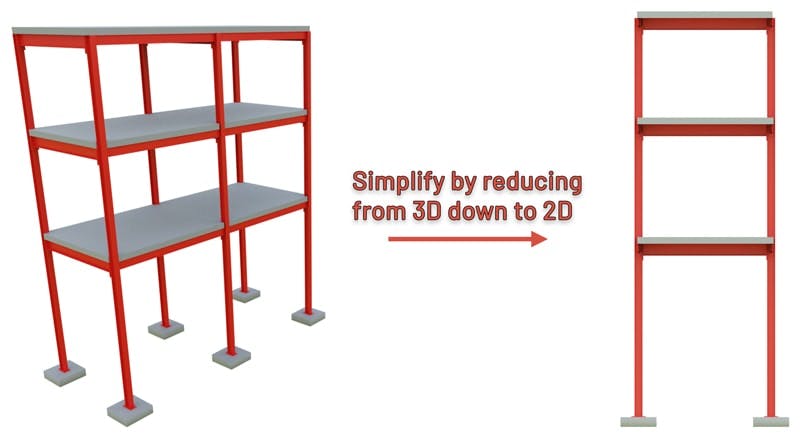
Fig 2. We can often approximate a 3D structure with a 2D model with little loss of accuracy.
Full three-dimensional structural analysis can’t always be avoided of course, but the task of expanding from 2D to 3D is usually just a matter of extra computation rather than becoming theoretically more complicated. So in terms of learning – you’ll start by analysing 2D planar structural models. Because it takes so much longer to perform 3D analysis using hand calculations, you generally won’t do this. Instead, you’ll write code or use prewritten software to perform 3D structural analyses…further down the line when you have a very solid grasp of the fundamental manual methods. A good rule of thumb is, if you don’t have some idea how to analyse a 2D approximation of the structure by hand, you should probably think twice about relying on a computer to analyse it.
3.2 Determinate versus indeterminate structures
Determinate structures are those that can be analysed using simple equations of statics. For a 2D planar structure, this means that there can be no more than 3 unknown reactions since we have three equations of statics in the 2D plane, Fig 3. Statically determinate structures are a great starting point because you can build up your understanding of many critical concepts and techniques by working on these simple structures. So, for example, you can concentrate on getting really good at drawing shear force and bending moment diagrams for beams and frames without worrying about more advanced techniques.

Fig 3. Statically determinate structure that we can fully analyse using 3 equations of statics.
Unfortunately, you quickly find out that not many practical structures are statically determinate. This roadblock is first encountered when you need to analyse a structure with more than three unknown reactions, Fig 4 for example. There are many tools we can use to ‘unlock’ these structures, from elegant solutions that use things like virtual work, to more brute force (but also elegant : ) approaches like stiffness method (matrix) analysis. You typically start being introduced to these in the second year of an undergraduate programme.
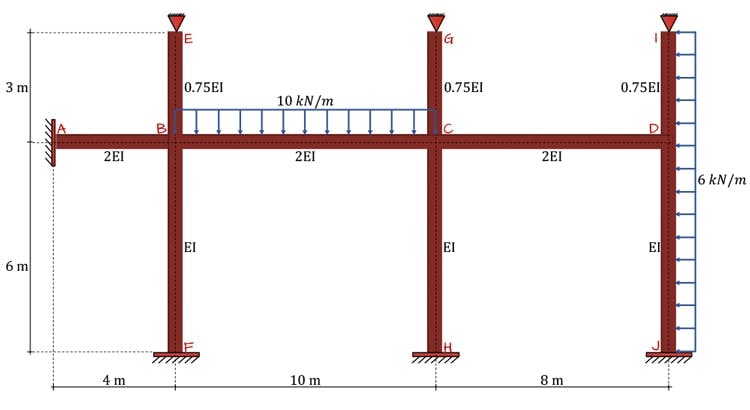
Fig 4. Statically indeterminate structure that we cannot fully analyse using only the equations of statics.
3.3 Statics versus dynamics analysis
In a static analysis, the rate of change of velocity of all mass in the analysis is zero or so small that any inertia forces are insignificant. Put another way, everything in a static analysis is assumed to be static or stationary. This is the starting point; any forces we apply to a structure result in a single deflected shape that is a function of the structural stiffness and does not vary with time. Most engineers like to stay in the ‘stationary world’, which is understandable!
In a dynamic analysis, we cannot ignore the inertia forces. The masses involved have non-zero accelerations and as such experience inertia forces and usually damping forces, Fig 5. The behaviour of the structure results from the influence of all of these forces and varies with time. Dynamic analysis of elastic bodies is typically introduced in the second or third year and very often only explores single-degree of freedom systems. Larger dynamic systems, so-called multi-degree of freedom systems, may be covered, but usually at Masters level or at a relatively superficial level at undergraduate level.
Dynamic analysis makes heavy use of calculus and perhaps for this reason it often turns students off. This is unfortunate because it really is a vitally important skill set to acquire and a fascinating area to study once you get to grips with the mathematics.
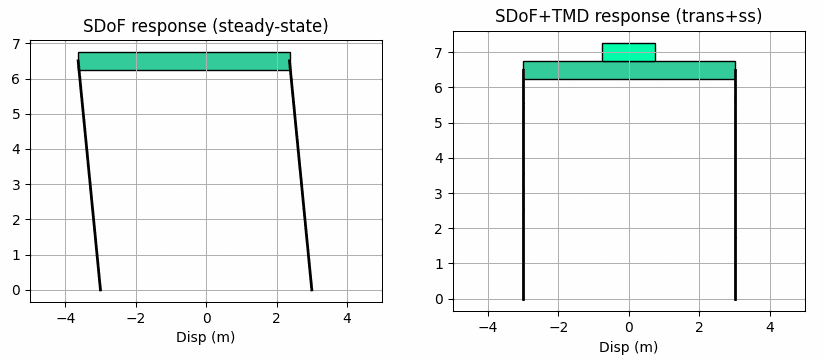
Fig 5. A single-degree-of-freedom system subject to base excitation (left) and the same system influenced by a simple Tuned Mass Damper (right). An understanding of structural dynamics is essential if the engineer is to determine the stresses induced within the structure as a result of this motion.
3.4 Linear versus non-linear analysis
Linear analysis assumes that the deflection of the structure is linearly proportional to the applied load. In other words, if you double the applied load, you double the deflection. Most structures exhibit linear behaviour, at least for a certain range of loading. However non-linear structural behaviour is sufficiently prevalent that engineers need to understand why it occurs and how to include it in our analyses.
Non-linear behaviour can arise due to material non-linearity, geometric non-linearity or a combination of both. A common example of geometric non-linearity that you will explore is column buckling. Plasticity and plastic hinge formation is an example of material non-linearity that you will explore. Non-linear structural behaviour is usually encountered in the third year of study when you have a solid understanding of linear behaviour. Non-linear behaviour very often precedes structural failure and as such it’s important to understand how structures respond under these ultimate limit state conditions.
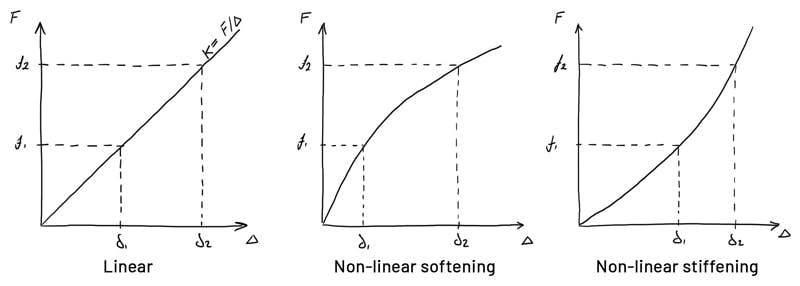
Fig 6. Left: classic linear behaviour where force is linearly proportional to displacement. Middle: Non-linear softening where the structure exhibits progressively larger displacements for the same increment of applied load. Right: Non-linear stiffening where the structure gets progressively stiffer as the load is increased.
Another quirk of non-linear behaviour is that it very often requires iterative analysis whereby the structure is analysed and the results of this analysis feed into a subsequent iteration of the same analysis. This makes the process tedious if not implemented programmatically. So, having some familiarity with a coding environment, e.g. Python (free and amazing : ) or Matlab (expensive walled garden!) becomes a huge asset as you start to go beyond basic structural analysis.
3.5 Qualitative versus quantitative analysis
The distinction between these two types of analysis is best illustrated with a specific example. Consider the deflection of a simple 2D framed structure. Quantitative analysis would result in us evaluating a specific numerical estimate of the deflection at a specific point. To achieve this we would proceed through our analysis procedure making use of all of the relevant information about the structure such as dimensions, cross-sectional areas and Young’s modulus. This would be a detailed and likely length analysis and if anything about the structure changed, we would update our analysis appropriately. Quite often we don’t need this level of detail. At an early stage in the analysis of the structure, we might not even possess the required information to produce a meaningful quantitative analysis.
This is where a qualitative analysis would be useful. A qualitative analysis would simply yield an estimate of the overall deflected shape. This is a quick sketch of the exaggerated deflected shape without specific numerical values. Qualitative analyses can yield a lot of valuable information about how we expect the structure to respond to loading, e.g. we can predict which faces of the structural elements will be in tension and compression, the direction of reactions and the direction of sway, all of which will be useful in the early assessment of different structural solutions.
Although qualitative structural analysis sounds easier to produce, this is a little misleading, it is faster but accurately assessing qualitative structural behaviour requires an excellent understanding of structures which only comes with practice. We can think of quantitative analysis as ‘painting by numbers’, if we know the procedure we can usually determine the result. Qualitative analysis usually requires an artists mastery of the behaviour. For this reason, qualitative analysis is usually something that is honed towards the end of a degree programme.
Qualitative analysis questions are also a favourite among senior engineers testing potential candidates for graduate engineering roles! I can still remember a senior engineer from Arup grilling me on the qualitative behaviour of a twisting multi-storey tower in my very first interview – it was definitely a ‘think on your feet’ moment that I could only tackle with a good appreciation for qualitative structural behaviour.
3.6 Manual versus computerised analysis
The last distinction I want to draw before we consider a detailed curriculum is between manual analysis that we complete using hand calculations and computerised structural analysis. This is a loose distinction because we could obviously write some code to perform any analysis we can do by hand. Generally speaking, you will start learning analysis techniques that can be easily implemented on paper. This is partly because it removes the frustrations associated with learning to code but also because it helps you to understand more clearly how a given analysis technique works. While programmatic implementation is excellent for speeding things up and making the analysis process efficient – it should really only be used when you clearly understand what you’re implementing. There are some techniques, matrix-based method of analysis for example, such as direct stiffness method/finite element method that only really make sense to implement in code – but these analysis methods should only really be approached when you clearly understand manual analysis techniques for statically determinate structures.
The computerised analysis I’ve mentioned so far has referred to code you write yourself to implement an analysis technique. However, there are plenty of software tools available that allow you to build a structural model and then simply push a button to get the results. Some of these tools are even available on this website. They certainly have their place – modern design offices could not function profitably without the speed and efficiency provided by modern commercial structural analysis software. However, they should be considered as tools employed for efficiency and not as a substitute for understanding the underlying structural behaviour. This can’t be stated strongly enough.
The danger is that faced with trying to decipher manual methods of structural analysis, the student opts for a shortcut and begins to rely heavily on analysis software before developing their own robust understanding of structural behaviour. Don’t fall into this trap – without understanding the fundamentals, it is incredibly easy to misinterpret the output from an analysis package. It’s also incredibly easy to make fundamental errors when trying to recreate a model of the structure inside the analysis package. If you have no idea what to expect the result to be, you have no way of assessing the validity of the computer output and identifying errors you may have made when building the model.
For all of these reasons, you should probably steer clear of commercial software packages until at least the second and more likely the third year of study. However, you can and should dabble with writing your own code as soon as you understand each new topic – the quicker you get comfortable translating your manual calculations from paper to code, the better. Oh, and do yourself a favour – bypass Excel (the tool of accountants) and jump straight into Python (the tool of engineers and scientists) or some similar scripting language.
4.0 A Structural Analysis Roadmap
With all of that out of the way, let’s take a look at what a sensible 4 block structural analysis curriculum might look like. I say 4 block instead of 4 year because it’s perfectly possible to cover the material in a block in a lot less than a year! A typical academic year consists of two 11 or 12 week teaching terms in which a lot of other material is also covered. So, if you’re just focusing on structural analysis with a reasonable time commitment, you should expect to cover this material in significantly less time. Like any new skill, how quickly you pick it up and how good you get is a function of the effort you put in – you should expect to spend many hours practising different analysis techniques AFTER you’ve covered and understood the core theory.
4.1 Block 1 – Statically determinate structures and the link to underlying stresses
Block 1 focuses on developing a solid foundation in basic structural analysis. Many of the skills developed in block 1 will serve as the foundation for later topics which layer on additional complexity. Block 1 emphasises manual structural analysis of statically determinate structures. This is to help you start to build up an intuition for qualitative structural behaviour before becoming too reliant on computerised analysis. You should confine yourself exclusively to static analysis of planar 2D structures at this stage. As mentioned above, this allows you to dispense with the additional computational overhead of 3D analysis, instead, focusing on embedding the fundamental concepts.
In addition to determining internal structural actions; axial forces, shear forces and bending moments, you should also explore the internal stresses that give rise to these stress resultants. This allows you to understand the full chain of events that result from applying a force to a structure, i.e. forces induce strains (which we observe at a large scale as deflections) which give rise to stresses that can be represented by their resultants, namely the axial forces, shear forces and bending moments that our previous analysis techniques have identified.
After completing block 1, you will have a sound understanding of analysis techniques that apply to statically determinate 2D structures. This means you actually have a surprisingly versatile analysis toolkit at this early stage in your development; you will be able to evaluate internal axial, shear and bending actions (resultants and stresses) and to estimate the associated deflections using virtual work techniques. The content from this block should be considered a prerequisite before you start using structural analysis software. These early topics are so fundamental to everything that follows, that it can’t be overstated how important it is to master this material for an easier life, down the road.
In summary, the key things to cover are:
Fundamental Static Analysis 🔗
- Foundational content that serves as the basis for everything that follows
- Forces, moments, equilibrium and basic static analysis
- Analysis of statically determinate pin-jointed structures
- Joint resolution method
- Method of sections
- Truss determinacy
Bending and Shear for Statically Determinate Beams and Frames 🔗
- Understanding internal shear forces and bending moments
- Methods for determining the shear force and bending moment diagrams
- Differential relationships that link loading, shear force and bending moment
Virtual Work Analysis of Truss, Beam and Frame Structures 🔗
- Principle of virtual work
- Methods of analysis for axially loaded structures
- Methods of analysis for bending structures
- Allows you to use what you’ve learned previously to manually evaluate structural deflections
Stress Analysis and Mohr’s Circle 🔗
- A complete introduction to flexure and shear stresses and their relationship to each other.
- Plane stress, plane strain and Mohr’s circle of stress
- Develop a clear understanding of the link between internal bending moment and shear force with the associated internal stresses
4.2 Block 2 – Indeterminate structures, load-paths and leveraging a code to scale your analyses
Block 2 introduces your first technique for statically indeterminate structural analysis, the moment distribution method. This simple iterative analysis technique will be deployed to analyse indeterminate beams and frames, greatly expanding the range of flexural structures that can be analysed. This builds on the study of bending and shear from block 1 and relies on a sound understanding of this foundational material. This analysis technique will provide a fast way of manually performing subframe analysis of larger structures – a useful and practical manual technique even in the age of computerised analysis.
You will also build on your understanding of virtual work developed in block 1 and deploy it for the analysis of relatively simple indeterminate structures. The aim is to explore how a combination of virtual work and superposition can be used to analyse indeterminate structures that combine both beam and axially loaded elements. This is our first introduction to hybrid structures that combine truss (predominantly axially loaded) elements with flexure elements and marks another milestone in your analysis capabilities.
All analysis thus far has been static and ignored the influence of inertia and time-varying forces. Block 2 introduces dynamic analysis of elastic structures and highlights the fact that static analysis is simply a subset or special case within a wider dynamic analysis framework. In exploring dynamic analysis, we introduce damping and inertia forces that are considered insignificantly small in the content of static structural behaviour. The focus at this point is on single-degree-of-freedom systems as these will be essential for modelling multi-degree-of-freedom systems later.
Next, you should take a step back from individual element analysis techniques and consider overall structural stability and response to loading. At this point, you should become familiar with the concept of a load path and start to see how individual analysis techniques can be combined to build a more complete picture of the overall structural response to loading. The objective here is to start viewing structures as systems of load transmission with your job being to ensure loads have a safe path back down to the ground. By safe path, we mean that none of the structural elements that transmit that load experience deflections or stresses that exceed their safe and acceptable limits.
The final focus in block two is an introduction to matrix-based structural analysis and the direct stiffness method. The aim of the static analysis techniques explored up to this point has been to help develop an intuition for structural behaviour and an ability to qualitatively estimate structural response. This intuition for structural behaviour really is one of the most difficult things to develop as a student of engineering and can only come from many hours of practice and application of the basic techniques. With this foundation established, we can turn our attention to scalable analysis strategies. To leverage the flexibility of matrix-based analysis it’s best to shift into a coding environment. The link is also made at this point between manually implemented direct stiffness method solutions and typical commercial analysis packages.
The goal at the end of block two is for you to have an understanding of how computerised structural analysis is achieved, appreciate the importance of inertia and structural dynamics and also have a clearer understanding of how overall structural stability is achieved within complete structures. Routine use of commercial structural analysis tools to perform linear 2D planar structural analysis is no longer discouraged as an understanding of the underlying theory should have been achieved.
The block two summary is as follows:
Analysis of Indeterminate Beam and Frame Structures using Moment Distribution 🔗
- Build on analysis of statically determinate structures
- First introduction to indeterminate structural analysis
- Valuable analysis technique for manual but relatively fast subframe analysis
Virtual Work Analysis of Indeterminate Structures 🔗
- Expand virtual work to analyse indeterminate structures consisting of a combination of bending/shear and axial elements
- The first technique that addresses these hybrid structures
Dynamic Analysis of Single Degree of Freedom Systems 🔗
- First introduction to dynamic analysis of elastic systems
- Recognise static analyses as merely a subset of dynamic analysis
- Focus on SDoF free vibration, harmonic excitation and response to general dynamic loading
- First introduction to coding as a tool for structural analysis -> necessitated by nature of dynamic analysis
Load Path, Structural Systems and Stability Analysis of Structures 🔗
- Step back from individual element analysis and consider the behaviour of the overall structure
- Load path analysis
- Stability analysis (employing different stability systems)
- Deploy element analysis tools to build a picture of overall structural behaviour and response to loading
Matrix Analysis of 2D Truss Structures 🔗
- Introduction to the finite element method generally and direct stiffness method specifically
- Implement within a coding environment
- Focus initially on linear behaviour of 2D truss structures
- Appreciate the simplicity and scalability of a finite element approach
Matrix analysis of 2D Beam and Frame Structures 🔗
- Expand from the analysis of trusses to include bending and shear of beam (1D) and frame (2D) structures
- Once this is well understood, routine use of analysis software (for speed and efficiency) is acceptable
4.3 Block 3 – More dynamics, an introduction to non-linear structural behaviour and supercharging your matrix analysis
The emphasis in block 3 is predominantly on deepening your understanding developed in block 2 in the areas of dynamics and matrix-based analysis. In terms of dynamics, we expand into multi-degree-of-freedom systems and explore various methods of solving for dynamic behaviour. We introduce the hugely important technique of modal superposition for linear systems and also cover direct integration of the equations of motion for non-linear systems. Knowledge of modal analysis from block 3, combined with knowledge of SDoF systems from block 2, unlock the dynamic behaviour of a huge array of complex structures.
You will further develop your understanding of matrix-based analysis techniques by expanding into the analysis of 3D structures. First, we introduce space frame structures, i.e. 3D trusses consisting of only axially loaded members. Having established a foothold in 3D structural analysis we turn our attention to the analysis of 3D beam and frame structures. While it is possible and likely more efficient to model these structures using commercial software packages, a deeper understanding of the analysis is achieved by implementing the analysis manually (writing our own code) and tackling the various challenges that crop up when expanding from the 2D to 3D environment. Once this has been achieved, a complete understanding of the typical software analysis workflow can be claimed. Implementing 3D structural analysis solvers is equally a coding exercise that will sharpen your development and problem modelling skills. Once complete, you should be confident to deploy coding as a force multiplier in many engineering problem-solving tasks.
In block 3 we also take a first look at non-linear structural behaviour. First, we consider a form of geometric non-linearity; column buckling. In addition to geometric non-linearity, this will introduce the important concept of Euler buckling and stability. Material non-linearity is then introduced in the form of elastoplastic bending and hinge formation in statically indeterminate structures. This study of non-linearity will introduce you to a new level of complexity in structural behaviour modelling and equips you with an appreciation of the dangers of ignoring or not appreciating 2nd-order effects.
Mastery of block 3 and all of the material before it is a good marker of the standard required for a typical Bachelors Degree in Civil or Structural Engineering. The finer details and specific topics may vary between academic programmes, but fundamentally you will understand:
- Methods of structural analysis for both statically determinate and indeterminate structures
- The fundamentals of structural dynamics and what differentiates a static and dynamic analysis
- How modern computerised structural analysis is achieved using matrix-based analysis
- Non-linear structural behaviour arising from both geometric and material non-linearity
- Load paths, common vertical and lateral structural systems employed and how to model building behaviour using simplified structural models
- The link between structural behaviour and the underlying stresses and strains
The subject summary is as follows:
Dynamic Analysis of Multi-Degree of Freedom Systems 🔗
- Modal analysis and modal superposition for linear structural behaviour
- Direct numerical integration of equations of motion for non-linear behaviour
Column Buckling Behaviour 🔗
- First introduction to non-linear structural behaviour and stability
- Column analysis with idealised end conditions
- Column analysis with eccentric loading and initial deformations
Plasticity and Plastic Collapse Analysis 🔗
- First introduction to plasticity (material non-linearity) and elastoplastic bending
- Plastic collapse analysis and hinge formation in indeterminate structures
Matrix analysis of 3D Space Frame structures 🔗
- Expansion into matrix-based analysis of 3D Space Frames (axially loaded structures)
- Expands on the analysis of 2D trusses and provides a first introduction to 3D structural analysis
Matrix analysis of 3D Frame Structures 🔗
- Expands into beam and frame analysis in 3D
- Particular emphasis on how to manage orientations and transformation in 3D space
4.4 Block 4 – Finite Element Analysis, Non-linearity and Complex Structures…the really interesting stuff
In block four you are going beyond the minimum requirement for a typical Bachelors degree and in reality, you’re going beyond what most engineers will typically need to use on a daily basis. But just because you don’t use something on a daily basis, doesn’t mean you shouldn’t have some familiarity with it that you can draw from and build on when required. This material would generally correspond to elective Masters level degree content. The topics covered here are just a selection of possible things to explore. Furthermore, you can consider the subjects I mention below as entry points into a much deeper study of that particular area. Many a PhD project has been borne out of a student’s curiosity at the limits of their final year classes.
The first suggestion is to further develop and deepen your understanding of matrix-based analysis through the development of finite element models for continuum structures. Thus far, your stiffness method analysis has focused on linear structural elements. Next, you should consider continuum elements that allow you to model the stress distributions within your structures. This will present an excellent opportunity to link up with the fundamental models of stress distribution you covered in block 1, closing the circle in a way. You could also consider exploring how your understanding of non-linearity from block 3 can be built into the matrix analysis of linear structures you’re already comfortable with. At this point, you can be somewhat guided by your imagination and own curiosity in exploring how different topics you’ve covered in the past can be blended together and combined.
Next, I recommend an exploration of the behaviour of plate (2D) and shell (3D) structures. Plates and shells are common structural forms and an ability to understand and model their behaviour will be a huge asset to any structural engineer. For a broad spectrum understanding of their behaviour as well as how to practically analyse them, you should study closed-form analytical models as well as how to build your own finite element models – although building your own FE models is really just for the enthusiast and not strictly necessary! Building 3D finite element models will build on the understanding of 2D continuum structures you’ve already developed.
The final topic which I highly recommend all engineering students have some exposure to is stochastic analysis of structures and environmental loading – sometimes referred to as structural safety and reliability analysis. This will introduce you to probabilistic models that all you to assess the likelihood of structural failure and give you a better understanding of the characteristics of highly variable environmental loading. Understanding that structural performance and potential failure exist on a spectrum with associated probability is another important milestone in your understanding of how the built environment responds to loading.
Again, I should emphasise that there is any number of other topics that one could swap with what I have listed below. But if I was asked to specify a final year of academic study that would result in an extremely well educated structural analyst – these would be my recommendation. You’ll also note that, unlike the previous blocks, there are few course links below. At the time of writing, these courses are not yet available on DegreeTutors – but I’ll be addressing that over the next 12 months! Sign up to my mailing list at the bottom of the page of you want updates on when these courses are released.
Finite Element Analysis of Continuum Structures 🔗
- First introduction to finite element analysis of continuum structures rather than linear element / frame-based structures
- Uses much of the understanding already developed during previous matrix-based structural analysis
- Helps to reinforce the understanding of stress distribution that was first introduced in block 1.
Geometric Non-linearity and Iterative Matrix Analysis 🔗
- Introduce geometric non-linearity into our matrix-based structural analysis.
- Develop models and techniques for performing iterative analysis of non-linear structural behaviour
- Greater appreciation for the potential importance of considering second-order effects
Theoretical Analysis of Plate and Shell Structures
- Analytical models for the behaviour of plate and shell structures
- Introduction to the membrane theory of shells
- A necessary prerequisite to the exploration of finite element analysis of plate and shell structures
Finite Element Analysis of Plate and Shell Structures
- Builds on and combines the previous analytical study of plates and shells and continuum finite element analysis.
- Develop tools for the computerised analysis of complex 3D continuum structures
Stochastic Analysis of Structures (Safety and Reliability Analysis)
- An introduction to stochastic structural analysis and first departure from deterministic structural analysis
- Exploration of extreme value statistics and their application to modelling probability of failure
- Builds an understanding of how modern code-based design bakes in statistical analysis through partial factors
- Appreciation for the variability inherent in environmental loading
5.0 Wrapping up and getting started!
If you’ve made it this far you now have a complete structural analysis roadmap to take you from your first introduction to the concept of equilibrium, all the way up to the complete analysis of complex 3-dimensional structures. As I’ve already said – this is just one potential sequence of learning – others arrangements of topics are possible, particularly as you progress into the later material. At a certain point, you should be influenced as much by your own curiosity and let that guide you on what you should study next. Whatever route you choose, I hope you enjoy the journey and find it as fulfilling and stimulating as I still do.
Many of the resources linked to above are completely free (e.g. tutorials and Python projects but if you want full access to all course content for one low annual fee, consider subscribing to my All Access Annual Membership. You can read more about the benefits of Membership here or skim the headlines and subscribe directly below.
All Access Membership
Learn, revise or refresh your knowledge and master engineering analysis and design
Access Every Course and Tool
- Over 1140 lectures & over 234 hours of HD video content
- Access member-only 'deep dive' tutorials
- Access all downloads, pdf guides & Python codes
- Access to the StructureWorks Blender addon + updates
- Packed development roadmap of courses & tutorials
- Price Guarantee – avoid future price rises as we grow
- Priority Q&A support
- Course completion certificates
- Early access to new courses
Dr Seán Carroll's latest courses.
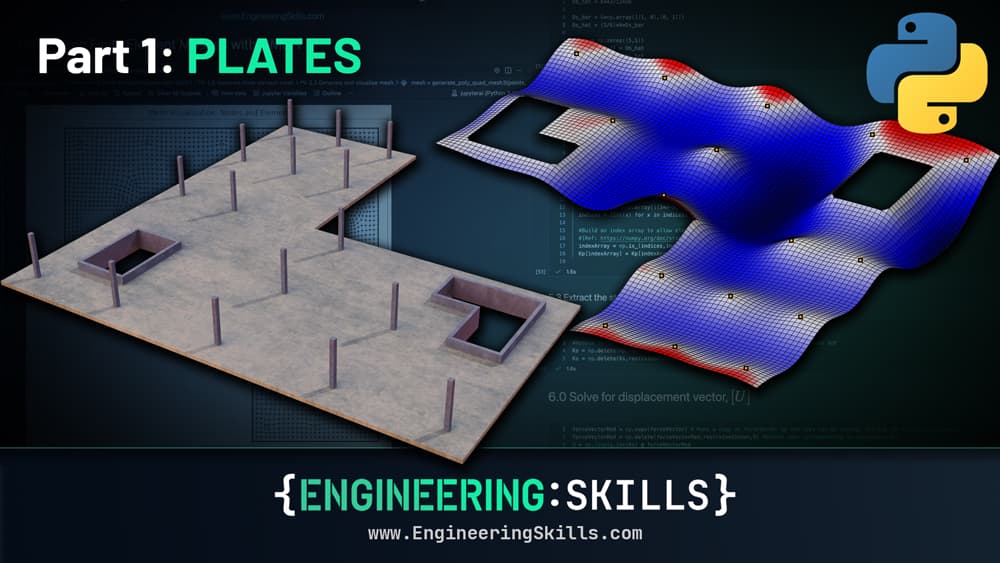
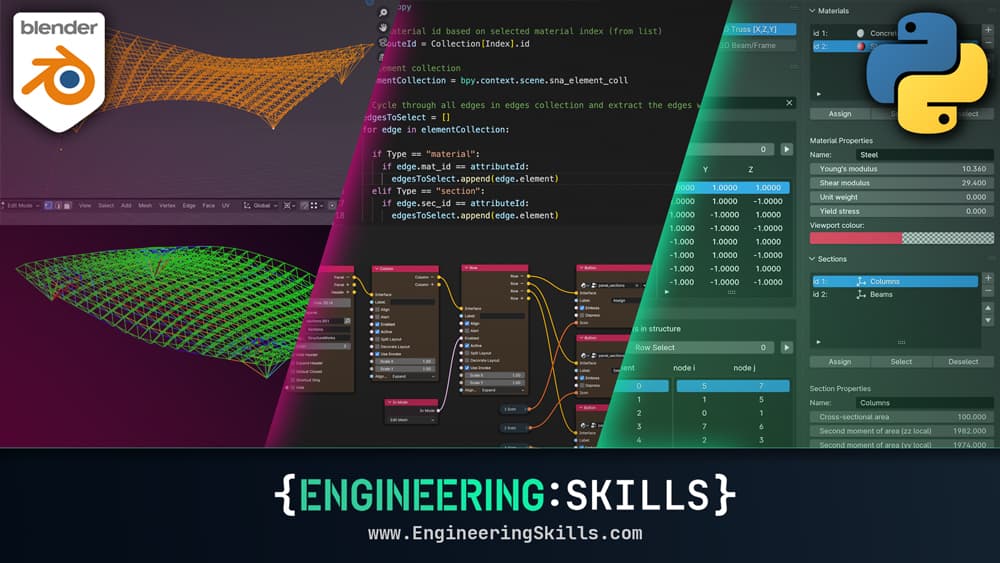
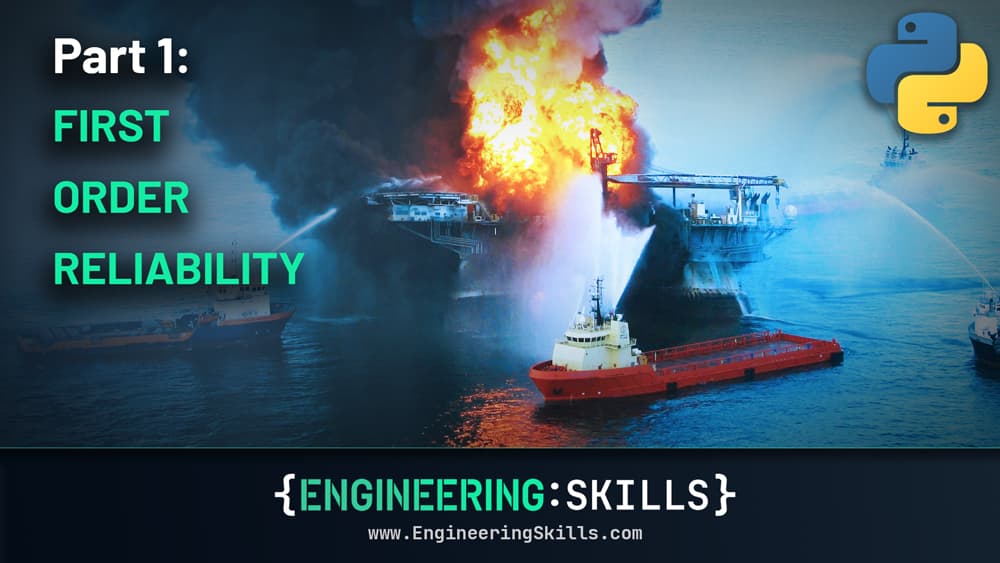
Featured Tutorials and Guides
If you found this tutorial helpful, you might enjoy some of these other tutorials.
Plastic Analysis and Plastic Collapse – A Complete Guide – Part 1
Use plastic analysis to determine the collapse load factors for determinate and indeterminate structures.

Callum Wilson
Building a Mohr’s Circle Calculator for Stress Analysis in Python
Once complete, you will have your own stress analysis Python code

Dr Seán Carroll
Bonsai BIM - The Essential IFC Tool for Structural Engineering Workflows
The IFC tool every structural engineer should have in their toolkit

Petru Conduraru


